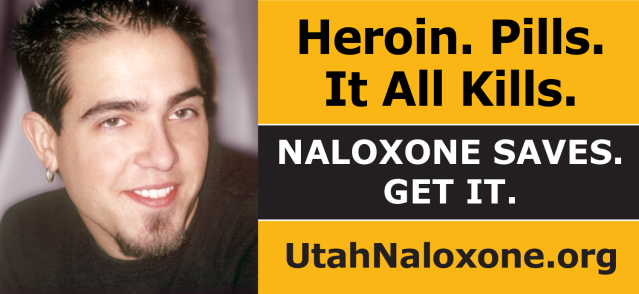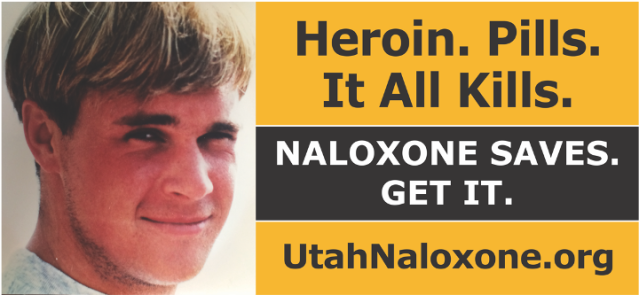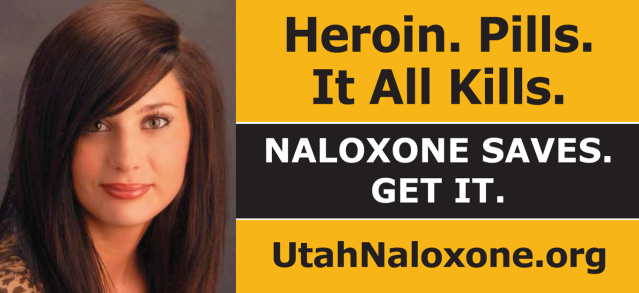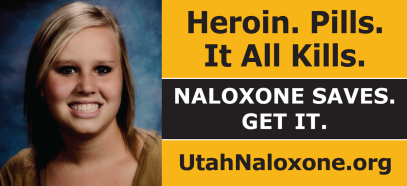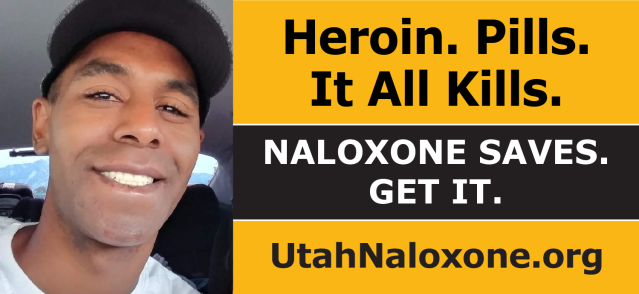HEROIN. PILLS. IT ALL KILLS. UTAH Billboards: The Human Stories Behind the Faces
Each of the faces you see on this billboard campaign was someone dearly loved and lost to an opioid overdose. These were sisters and brothers, sons and daughters, friends and family...people cherished and missed still. These are just a few of the victims of this crisis. The pain of their losses spreads deeply. The stories below are contributted by the families of each who was so loved.
It is our hope that putting a face to this epidemic will help others realize that overdose death can happen to anyone. Opioids do not discriminate. Please reach out if we can help you get naloxone in your hands to potentially save someone from an opioid overdose. They mattered.
Joshua Sam Kresser
9-29-81 ~ 9-30-06
“If love alone could have saved you then you would have lived forever”
Josh grew up in Salt Lake City with his parents Layne and Sandra, his twin brother Jake and his younger siblings Amy and Alex. One
thing prominent about Josh was that he always cared for other people - a twinkle in his eye that shined through his darkest times. Part of it stemmed from his adventurous spirit and his unforgettable
comedic timing. Another part of it was his unleashed potential waiting to share joy and overcome sorrow with those he loved.
When Josh was 22 he was prescribed into addiction after a back injury he sustained at work. Over the next 2 1/2 years he tried hard
to break free from the chains of his disease but was held captive by a dangerous addiction to powerful prescription opioids. He had the love and support of his family and friends but sadly in the end
was unable to overcome.
Josh had just finished his third inpatient program and was living in a sober living home in California. He was looking forward to
finally being able to move on with his life and wanted to be able to help others struggling with the disease of addiction. His back was still bothering him and the doctor he saw knew his complete
history of opioid addiction and heroin use but chose to prescribe to him anyway. He told Josh that he had “legitimate pain” and as long as he took these meds exactly as he prescribed them he would be
just fine. He was anything but fine….. One day after Jake and Josh celebrated their 25th birthday Josh passed away from a lethal combination of these prescribed drugs - all taken exactly as
prescribed and all at therapeutic levels.
At the time of Josh’s death naloxone wasn’t available for use in the rehabs and sober living houses he was in. Thankfully, that has
changed and this lifesaving drug is readily available to anyone to help save these precious lives and to be able to give them the gift of hope. As long as they are still breathing there is
hope!
Josh was so loved and will be forever missed by all who knew him.
Tennyson Adam Abraham Cecchini
Tennyson was born on 20 April 1982, the first born son of Celeste and Dennis Cecchini. Celeste was a Display Designer with ZCMI and Dennis a practicing Architect, both in their thirties. They relocated to Salt Lake City in 1972 after their marriage in Kenosha, Wisconsin.
Tennyson, even as a baby was a beautiful boy; gregarious, inquisitive and full of the joy that a spirit invested in life can display. The first 24 years of his life contained all the experiences that help a young person grow to productive adulthood. And friends always came easy to Tennyson as they were attracted by his personality and his attention to them. He attended public school, performed with the choir in Junior High School and always had trouble with math. In High School he became very good at Hockey and won his letter two years in a row. He attended Weber State University but left one semester short of graduation unable to fulfill his math requirements.
After college, he taught skating to children at a Taylorsville ice rink while he continued to play hockey and worked for a time in his father’s firm as a runner. He later got a position with a local health care equipment supply company and worked his way up from driver to warehouse and transport manager to store manager of the company’s flagship store. He developed the management plan for the company that was implemented in all of their stores throughout Utah. About this time Tennyson met a young women whom he loved. They were engaged to be married and together they had a beautiful baby boy.
Tennyson always had some difficulty sleeping, but in his 20’s his insomnia became much worse and contributed to intense feelings of anxiety. He also sustained a sever shoulder injury playing hockey which forced him to see a Doctor for the condition. He was given medication to help him sleep and an opiate pain killer for the shoulder pain. This began the unravelling of Tennyson’s life.
He became addicted to opiates and spent the next nine years pursuing a life predicated on addiction. Keeping his illness from his family. Trying to function on drugs. Losing all of his wealth and personal relationships. Tennyson finally told his parents that he had excessive credit card debt and moved into their basement to rebuild his finances. A year after that he lost his job and told his parents he was addicted to pain pills. His parents immediately helped him begin an outpatient treatment program for his addiction. But of course by that time Tennyson had moved on to an addiction to heroin and was very successful at keeping it from his parents. Because of federal confidentiality laws which can be problematic in dealing with this epidemic, his parents were kept in the dark about the true nature and extent of his illness and he did not recieve the aggressive treatment he needed.
His parents finally, about a year later, found out about just how terrible and life threatening his disease really was and forced him into residentail substance use treatment. Because he was an adult at the time the operative word was forced, as laws existing today make it impossible for loved ones to intervene in the health care decisions of an adult. Even one so obviously mentally impaired by addiction to opiates. Because of these laws and unconscionable insurance procedures which limit care for substance use. Tennyson left treatment after only 60 days. Although naloxone, an opiate reversing drug, was approved for use the year before by the Utah state legislature, Tennyson and his parents were never told about it and he was sent home without it. Four days later, Tennyson relapsed and overdosed on the bathroom floor. Celeste and Dennis were forced to watch the life of their beloved son pass away before their eyes as Celeste desparately CPR. Even the Police Officers who arrived first on the scene did not have naloxone to administer. By the time the paramedics arrived their son was dead. Dead at only 33 years of age and before he was able to fulfill all the promise of that young beautiful baby boy.
Maline
Maline grew up in a good home. She was a devout member of the LDS church who did not drink, smoke, or use drugs. In her 20's, Maline was going through an emotional time and began getting sick a lot. Doctors could rarely figure out what was wrong and began prescribing opiates for pain and benzodiazepines for anxiety. Maline found that these medications not only took away her physical pain, but also her emotional pain. Maline was slowly becoming addicted and she didn't even even know it.
She believed, like many, that she wasn't doing anything harmful becuase all of these drugs were prescribed. After over 15 years of being dependent on opiates, Maline's prescriptions were pulled and she was put on buprenorphine. Maline stiull struggled with her pain and her addiction and on August 24, she tried heroin for the first time. Maline went to sleep that night and never woke up. She died of a heroin and buprenorphine overdose.
Maline was an incredible person with the kindest, most loving heart. She loved her family fiercely and would never have chosen to leave us. Unfortunately, she would not get to decide that, an addiction to opiates would.
Andrew Nathan Plumb
The loss of Andy "The Eternal Kid" inspired the creation of Utah Naloxone. We have hope and true belief that we can help spare families and friends the pain of a preventable loss of one loved so dearly. This is what keeps this movement alive and fiercely dedicated. The mission of our organization can be described simply as a rescue mission. We are committed to empowering others to save the lives of people around them, people who do not deserve to die a preventable death. Substance use disorder and addiction are diseases, and those suffering should not be viewed or treated as deserving of a death sentence.
Andy was a kid born and raised in SLC, UT. He was adored by family and friends alike. He was so full of life and his energy was contagious. He was handsome, so funny, and epically kind. Andy was a middle class kid from the suburbs, and heroin was a big problem then in 1996. When we hear people say heroin is “now” in the suburbs…we know there is a different reality. This is not a new development, but it has certainly exploded everywhere. This problem has continued to grow since his death, and has grown to be a public health threat of epidemic proportion in every setting. Utah, our home, is been as high as fourth in the nation for its rate of overdose death and first in the nation for overdose deaths in its veteran population. If our brother or his friends would have had access to naloxone, we have no doubt that his life would have been saved the night of May 14, 1996. He didn't have to die, and this is true for those overdosing in the state of Utah, and across the nation today.
The night our brother died was the first time many would see our father cry. And the truth is that, as the only hero a little brother had ever known was overdosing on opiates and slowly dying, his friends left him in the basement, buried the paraphernalia and remaining drugs in the front yard, and left. 911 was not called, naloxone was never there, and he was not given the chance to survive that naloxone provides. This scenario is what we are hoping to prevent across our state. Since the founding of Utah Naloxone in July 2015, there have been thousands of lives saved in every setting you can imagine. They have been from mothers, fathers, brothers, sisters, wives, husbands, sons, best friends, law enforcement officers, security officers, and even from complete strangers. Empowering the broader community to save the lives of those around them and those they love is the key to stemming the tragic loss of life due to opioid overdose.
Simply put, people cannot get better if they are dead. Naloxone gives people an opportunity to find a way to a healthier place. His Life Mattered...truly, he mattered.
From Kenzie's Mom:
Burgandi Nay
From Burgandi's Mom, Kathy:
Burgandi was a beautiful, healthy, happy baby. She had a wonderful childhood and was raised in a loving home. Burgandi went to good schools and got good grades. She was smart, a hard worker, responsible, and independent. How then did she end up on the bathroom floor alone and dead from an opioid overdose at the age of 21? I was so naive about drug use and abuse. Burgandi started using drugs when she was 18, but I didn't know it. She never would admit to using drugs. Was I stupid to believe her? Did I do enough? Did she know I loved her? These are some of the questions I still ask myself. I live with the guilt of not helping her, not getting her into a rehab program. I didn't know. I didn't know about the many programs available for addicts and families.
There is a stigma that opioid users are homeless, dirty, and living on the streets. However, this simply isn't true. They are little girls, brothers, mothers, fathers, teachers, neighbors, doctors, lawyers, artists, and most importantly, they are the people we love. It isn't just the addict who suffers, their family and friends suffer too. Addiction is a family disease, and the suffering doesn't end when the life of the addict does.
There isn't anything I can do to bring my daughter back, but I can honor her by sharing her story without shame, and helping to educate other mothers, fathers, families, and friends. There are signs to look for and resources available.
Naloxone, a medication designed to rapidly reverse opioid overdose, is one of them. I had never heard of naloxone until my child passed away. Unfortunately, it wasn't used to save my daughter, but it might save yours. There is no reason why everyone shouldn't have this with them.
How did Burgandi go from happy and healthy to a heroin addict? I can put some of the puzzle pieces together and use my best guesses, but I honestly don't know. I do know I was a good mom, and she was a good kid. I do know that we can love the addict and hate the addiction.


